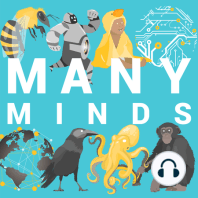68 min listen
The brain's many maps
FromMany Minds
ratings:
Length:
65 minutes
Released:
Nov 10, 2021
Format:
Podcast episode
Description
If you're a brain, it can be tough to stay organized. The world comes at you fast, from all angles, in different sensory formats—sights, sounds, smells. You need to take it all in, but you also need to parse it, process it, categorize it, remember and learn from it. And of course you also need react to it, preferably appropriately. So what do you do—as a brain—to handle this organizational overload? Well, for one thing, you make maps. Lots of maps. My guest today is Dr. Rebecca Schwarzlose, a cognitive neuroscientist and author of the new book Brainscapes: The warped, wondrous maps written in your brain—and how they guide you. Rebecca is former editor of Trends in Cognitive Sciences and is currently a postdoctoral scholar at Washington University in St Louis. Her book was supported by the Alfred P. Sloan Foundation’s program in the Public Understanding of Science and Technology. In this conversation, Rebecca and I talk about what brain maps are and why brains evolved to make them. (And just to be clear, it’s not just human brains—it’s the brains of many creatures.) We talk about how delightfully warped these maps are —and, of course, why. We discuss how we rely on them for vision, touch, smell, and movement, not to mention for thinking about faces, places, numbers, and more. We also discuss the fascinating duality at the heart of these brain maps, which is their balance of universal and unique features. I just love this angle on neuroscience, this way of thinking about the brain as a restless, prodigious cartographer. I thoroughly enjoyed Rebecca's book. And definitely there's a lot in it we couldn't touch on in this episode—details about how the mustache bat makes echolocation maps, for example, and about how new techniques are leveraging brain maps to do something like mindreading. So I hope you enjoy the episode, but I also hope you go and check out Rebecca’s book for yourselves. Alright folks, on to my conversation with Dr. Rebecca Schwarzlose. Enjoy! A transcript of this episode is available here. Notes and links 3:15 – A review article by Dr. Schwarzlose’s doctoral advisor, Nancy Kanwisher, on the fusiform face area. (Be sure to check out Dr. Kanwisher’s brain course online.) 8:00 – An article on Inouye’s work and the “discovery of the visual cortex.” 14:00 – Much work has focused on the metabolic costs associated with the brain. For instance, an article on how metabolic costs of the brain shift over development. 18:30 – A study of cortical magnification in V1 and how it relates to visual acuity. 21:00 – The famous “homunculi” of the brain’s touch maps are described and depicted in this article. 28:50 – A recent popular article on the brain’s maps of odors. 32:00 – Our interview with Asifa Majid about smell across cultures. 42:00 – An article about how numbers are represented in the parietal cortex. Another article about the relationship between finger discrimination and number discrimination abilities. 46:30 – An article about how the hippocampus supports thinking about the social world. 54:00 – An article about plasticity in the developing brain. 1:01:00 – One of Dr. Schwarzlose’s earliest studies, which was on face and body maps in the fusiform gyrus. Dr. Schwarzlose recommends the following books: Making Space, Jennifer Groh Into the Gray Zone, Adrian Own The New Mind Readers, Russell Poldrack You can find Dr. Schwarzlose on Twitter (@gothemind) and follow her work at her website. Many Minds is a project of the Diverse Intelligences Summer Institute (DISI) (https://disi.org), which is made possible by a generous grant from the Templeton World Charity Foundation to UCLA. It is hosted and produced by Kensy Cooperrider, with help from assistant producer Cecilia Padilla. Creative support is provided by DISI Directors Erica Cartmill and Jacob Foster. Our artwork is by Ben Oldroyd (https://www.mayhilldesigns.co.uk/). Our transcripts are created by Sarah Dopierala (https://sarahdopierala.wordpress.com
Released:
Nov 10, 2021
Format:
Podcast episode
Titles in the series (100)
Message to the stars: A conversation with Daniel Oberhaus by Many Minds
